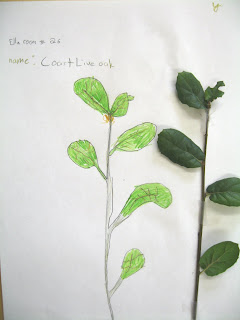The second grade engaged in observational drawing of plant life that was collected from our school yard. The children were encouraged to look closely at their specimen and to add lots of detail. This activity was introduced as a part of the larger second grade California wildlife mural project (more details on this project will be forthcoming). One of the students had the idea to tape her plant specimen to her drawing; several others liked this idea and taped theirs on as well.
Tuesday, April 12, 2011
Thursday, February 24, 2011
A Study of Seedlings
Ms. Sarabanda's 2nd and 3rd grade class recently planted lima beans. In Studio, they are recording the growth of the plants by drawing and painting them. Each one is numbered. Paying close attention to the details of each seedling, the students will monitor the growth of the plants through their study of the same plant next week.
 |
| First, a careful and detailed sketch. |
 |
| Students prepare watercolors. |
 |
| Students also learn to use sponges as a tool in their water-color work. |
 |
| Painting the roots of the seedling. |
 |
| Taking on the challenge of a seedling that is laying in the soil. |
Each water-colored sketch is then labeled with the student scientist's name, the date of the observation and the number of the plant.
 |
| The test strips also become works of art. |
Wednesday, February 23, 2011
Ms. Zeena's Kindergarten - An investigation of The Arctic
The Children in this class have been talking recently about many things having to do with "the arctic." They were interested in ice and snow and told many stories about their experiences in cold and snowy environments. Some children had been skiing or ice skating and many others had visited cold wintry places. The children read books in class about the arctic and saw a video which featured polar bears navigating on the ice.
As the classroom teachers and Studio teachers talked about the children's ideas and interests they realized two things: first, the children were intrigued by the way that their bodies move differently on icy and snowy surfaces; second, some of the children may not have had any experiences with ice and snow. In order to give all the children a chance to experiment with the properties of ice they (along with several parent volunteers) froze large containers full of water and placed them in the studio room for the children to explore.
At a point in the investigation the children decided to crush the ice on the ground and watch what happened when it was left out in the sun.
As the classroom teachers and Studio teachers talked about the children's ideas and interests they realized two things: first, the children were intrigued by the way that their bodies move differently on icy and snowy surfaces; second, some of the children may not have had any experiences with ice and snow. In order to give all the children a chance to experiment with the properties of ice they (along with several parent volunteers) froze large containers full of water and placed them in the studio room for the children to explore.
 |
| Ice can be strong or it can be weak. |
 |
| Ice can be sharp and jagged or it can be smooth and slippery |
At a point in the investigation the children decided to crush the ice on the ground and watch what happened when it was left out in the sun.
 | ||
| Students know water can be a liquid or a solid and can be made to change back and forth from one form to the other | *California Kindergarten Science Standard. |
Thursday, January 27, 2011
First Grade - Hands-On Experience with Simple Machines
 |
| The children experimented with foam insulation pipe cut in half. The result was a marble run - hill machine- that could be changed in many ways. They could bend it up and down, and from side to side. They could even make the marbles do a loop-the-loop and seemingly defy the laws of gravity! |
 |
| The nails and hammers provided experience with two different kinds of simple machines: The nail is a wedge machine and the claw of the hammer acts as a lever. |
Tuesday, January 11, 2011
Fifth Grade Amusement Park Design Team Challenge
After breaking up into small groups, the Walgrove fifth graders learned they were going to be theme park designers. The challenge before them was to design an amusement park ride based on the digestive system. The designs had to be tasteful in order to attract a variety of customers.
The first step was brainstorming.
Discussions and sketching out ideas ensued.
 |
 | ||||||||
Next came putting their ideas on paper.
 |
 | |
| Using research and reference tools. |
Video of groups talking out their initial ideas:
Subscribe to:
Posts (Atom)

























